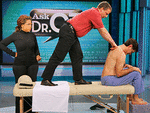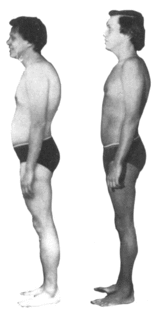
Posture
The Rolf® Approach To Posture
Rolfing is one of the best ways to improve posture, rooted in its cohesive understanding of the term itself. Dr. Ida Rolf, the founder of this system, often clarified the difference between posture and balance. The etymology of the word posture lies in the Latin word ponere meaning "to put” or “to place”. As a result of ithe common interpretation posture in such a manner, people often acquire the habit of holding a static, “correct” postural position.
Rolfing continuously seeks out a dynamic, creative balance in your body that is quite different from holding it in one rigid postural position that cannot easily accomodate the daily demands of life. Posture, as taught through Rolfing, is a creative, fluid process. With Rolfing, you move with correct posture, you do not hold. Rolfing will re-establish inherent balance to your properly aligned structure and how to let gravity do the work of providing support. This ultimately improve posture.
Rolfers® see the body and its structure as a series of interconnected and inter-related bony segments. Your body is designed to provide internal support for all these segments. Large sections rest on sections below them and provide support for sections that are above them.
Common Causes Of Bad Posture
Repetitive activities such as sitting at your desk, using a computer, and carrying children often contribute to bad posture and alignment. Forward head posture and swayback are common results of posture misalignment. Rolfing works to correct posture by lengthening the tissues in your body. Tight tissues and muscles are responsible for locking your body into poor posture. Unlike massage therapy, Rolfing works through the entire body to support proper postural alignment from your crown to your toes over a series of Rolfing sessions. An example of poor posture caused by sub-optimal body alignment is commonly seen in the relationship between the pelvis and the legs: Some people have developed a habit of storing tremendous amounts of tension in their hips, buttocks, and legs. This prevents their hip girdle from resting upon their leg bones in a way that provides maximum energy, range of motion, stability and stamina. Rolfing is a proven way to correct all of the above bad postures. The more we overload our musculature to compensate for our inability to move with grace, good posture and fluidity in our bodies, the more we unnecessarily tire ourselves. If you take up Rolfing and allow your system of internal support to operate in the way it was designed to operate, your body is freed to become a vehicle for your full physical expression, while maintaining the grace of better posture. The Rolf Philosophy On PostureTeachers of Rolf Movement Integration address these disruptions in structural balance in the bodies of our students and clients. We teach through hands-on manipulation and provide cues and prompts that help you regain your structural integrity. We are interested in the ways your feet contact the ground as well as the ways your head floats effortlessly on top. Through exercises and personalized coaching, we teach elongation without effort. One of the hallmarks of Rolfing is the attainment of improved posture as a result of surrendering tension and strain, as opposed to learning new ways of working hard, or trying to maintain a good posture. Rolfing clients often hear that they are not coming to learn to work harder in their bodies; they are coming to work less hard. The Benefits Of Rolfing To Your PostureThe goal of Rolfing® is to improve posture and flexibility, increase the range of motion of joints, and educate clients in movement and self-awareness. It dissolves old postural patterns that cause harm and chronic pain, thus differentiating Rolfing® from massage. The most common benefits of Rolfing® are that it: •
aligns, lengthens &
integrates the body Rolfing also benefits many people who do yoga, as their stretching improves after their posture and alignment is balanced. Rolfing also helps many athletes achieve their peak physical performance. The basic Rolfing series consists of ten sessions, with Rolfers always taking into consideration your posture as you step into the clinic. Each Rolfing session builds upon the results of the previous Rolfing session so that the results of Rolfing are cumulative. An average session consists of a Rolfing practitioner working on your posture from an hour to an hour and fifteen minutes. The terms Rolfing® and Rolfer® are registered trade marks of the Rolf Institute of Structural Integration, which has expanded on the work of Dr Ida Rolf. Their usage is restricted to certified Rolfers®.
The above shows difference in a person's posture after going through the 10 sessions of Rolfing posture
|

Certified Rolfer®
Vincent Lee
Rolfing was featured in


“Two Hands” 2007 Academy Award. Nominated for documentary film.

Andrew Weil, M.D.
“Good Morning From Dr. Weil.com” An on-line daily newsletter published a health news brief June 25, 2004--“Tip: Is Your Posture Bad? Today’s Tip-Rolfing."
